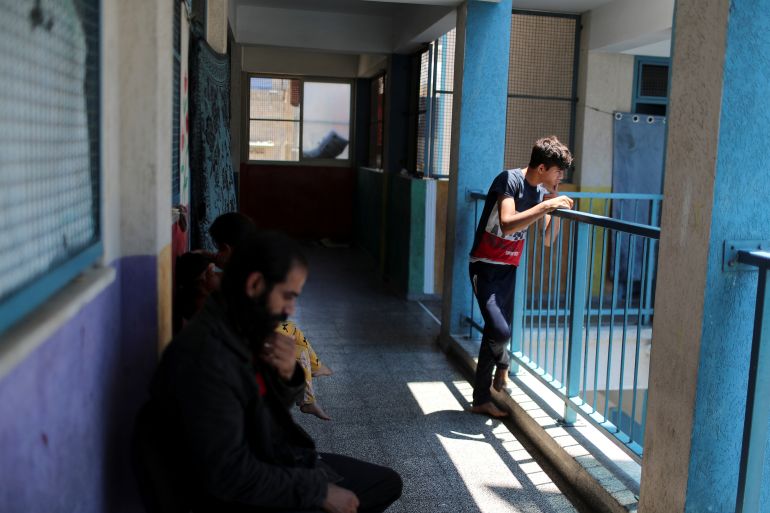4,000 Gaza students displaced after Israel attacks
After being hit by Israeli air strikes, two UN schools had to relocate thousands of students to other facilities.

While children around the world check their school supplies list and prepare to attend classes, 4,000 Palestinian students are caught up in uncertainty.
They do not know when – or if – they will be able to return to their familiar hallways and classrooms.
Keep reading
list of 4 itemsRocket fired at Israel from Gaza; first since May assault
Students in Gaza celebrate passing final exams despite war trauma
Israel attacks Hamas sites in Gaza in response to fire balloons
Despite their worries, like all pupils in Gaza, they began the academic year on August 16. However, classes took place in different schools, as their original educational facilities remain under investigation.
The chain of events started in May as an Israeli air strike damaged two, side-by-side, United Nations schools in the neighbourhood of Zeitoun, Gaza: the Preparatory Boys’ School “A” and the Elementary Boys’ School “A”. Both operate under the United Nations Relief and Works Agency (UNRWA).
Two weeks after a ceasefire, while assessing the damage and how to safeguard the premises from missiles, UN personnel found a cavity 7.5 metres in depth. And, from there, things quickly escalated.
Hamas, the group that controls Gaza, has acknowledged building a network of tunnels under the Gaza Strip for military purposes, but has not officially commented about the controversy surrounding these specific UN schools.
Last week, in order to verify whether the schools were safe to open for the academic year, a group from the United Nations Mine Action Service (UNMAS) tried to conduct a follow-up risk assessment of the structures.
Local police prevented the expert team from operating.
“Then we spoke to them [Palestinan authorities] again and the excavations are supposed to start again this week,” a spokesperson for UNRWA told Al Jazeera.
“UNRWA condemns the existence and potential use by Palestinian armed groups of such tunnels underneath its schools in the strongest possible terms”, noted a UNRWA statement. “UNRWA installations are inviolable, and their neutrality must be respected at all times.”
The UNRWA spokesperson said “the situation is being resolved”. For now, the students are attending other UNRWA schools, in different shifts, while they wait for clearance and are allowed to, hopefully, return to the schools they are familiar with.
Education in Gaza
With 278 schools across the strip and nearly 10,000 people serving as teaching personnel, UNRWA is responsible for the basic education of more than 290,000 Palestinian students.
Because of the shortage of facilities, some UNRWA schools operate on double and, more rarely, even triple shifts.
During Israel’s latest attack on Gaza, at least 51 educational facilities were damaged, including a UNRWA training centre, 46 schools, two kindergartens and parts of the Islamic University of Gaza.
“To be a child in Gaza today means that you have inevitably witnessed a level of trauma that your peers elsewhere in the world have not,” said UNRWA Commissioner-General Philippe Lazzarini in early July.
In a report issued in the same month, Euro-Mediterranean Human Rights Monitor said 91 percent of Gaza children suffered from post-traumatic stress disorder (PTSD) after the 11-day Israeli offensive in May.
According to the report, the recent Israeli attack had a huge effect on children: 41 lost one or both parents, almost 50,000 had their homes partially or completely destroyed, and thousands remain displaced.
With odds against them, there are still additional challenges for the students of Gaza. The delicate economic situation increases the risk of student dropout, as it puts pressure on children, particularly boys, to help support their households with additional income and leaves some families unable to pay for transportation or school materials.
Online classes
In a conflict where both sides are accused of war crimes, schools need a backup plan. In 2012, UNRWA launched UNRWA TV – a response to emergency situations in Gaza and Syria.
The YouTube channel provides self-learning supplements for students, teachers and families in emergencies who have limited or disrupted access to formal education.
Today, almost one decade later, the channel has more than one million subscribers, some 260 million views, and an average of 150,000 visitors a day.
For people who have access to the internet, it ensures that children can continue to learn in unstable areas and in conflict and post-conflict settings.
Psychological rehabilitation
Considering everything that Palestinian pupils need to go through, the education ministry in Palestine has a psychosocial support (PSS) programme for students.
It assists educators in helping children overcome, mentally and psychologically, the aftermath of conflict. A recent example of its efforts could be seen in the summer camps launched in early June.
In 150 centres across Gaza and with more than 50,000 students enrolled, the camps provided primary school students with knowledge, entertainment, emotional release and workshops related to Palestinian identity.
The financial support to establish the camps came from the ministry’s local and international partners and amounted to about $100,000. A high price. However, as the Palestinian Prime Minister Mohammad Shtayyeh stated: “No matter how high the cost of education is, the cost of ignorance is much higher.”
Engaged in educational activities, children so often betrayed by authorities, conflict and circumstance can at least try to find solace in one place: their minds.